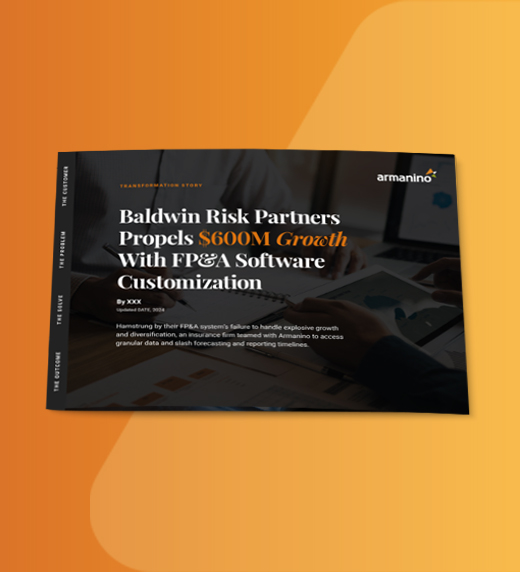
If you don’t already have corporate performance management software in place for your financial planning and analysis, your annual budgeting season is likely your most stressful time of year. Today, an effective budget process is difficult to achieve with traditional methods.
Here are six ways you can ease budgeting season pains by leveraging the powerful tools provided by a CPM platform.
As a first action item, outline the steps involved in your organization’s budgeting process, including the various reviews and approvals. Where does the process usually break down? Is work repeated? Examining who does what, and when (and asking why), can help you identify bottlenecks and potential opportunities for process and/or technology improvements.
Once you have this detailed view of your budget process, consider ways to improve your efforts. CPM software automates repetitive and manual processes such as importing data from a variety of sources, performing reconciliations, notifying users about pending deadlines or requested approvals, and streamlining the monthly or quarterly close.
All of this enables your finance team to spend more time analyzing data than reformatting it, provides a single version of your organizational data, and allows you to focus on a consistent budgeting methodology that produces more accurate results.
Still relying on spreadsheets? This is a major obstacle to an effective budgeting process. Far too often, teams work in separate copies of spreadsheet files that are amended by several people at once, making it difficult to know which file represents the latest version.
Swapping spreadsheets also introduces opportunities for errors — data can be entered incorrectly, formulas may change and alterations may break links in other workbooks or tabs. These errors generate a tremendous amount of time-wasting rework as the finance team hunts for mistakes and reconciles spreadsheets with mismatched or inaccurate data.
Instead, CPM tools create a central repository of budget and performance data, and allow business unit leaders to input information for their function without having to share or update spreadsheets. Sales data, and any changes to specific department budgets, are cascaded automatically throughout the organization so everyone has real-time access to the latest results and budget and can access a single, up-to-date version of the truth.
Another problem with annual budgeting is that, despite everyone’s best efforts, your data (and assumptions) can become outdated quickly in the face of shifting market conditions. This is frustrating, to say the least.
Instead of a static budget, CPM tools allow you to develop rolling forecasts that help you, on an ongoing basis, compare your actual financial results to your budget and understand quickly how the year is going against your plan.
Rather than making these comparisons manually, a CPM tool performs the calculations and displays the results on a customizable dashboard that provides on-demand, at-a-glance summaries as well as the ability to drill down into the data for more detailed analysis.
Being able to monitor your organization’s performance continually also improves cash flow management by providing early notifications of unplanned variances. The sooner your leaders understand a potential problem is brewing, the more time they have to make adjustments.
With traditional budget processes, functional leaders work on their unit’s spending plans and forecasts with limited insight into the organization as a whole. This often leads to a siloed approach marked by competition for resources, casual “just add 5%” proposals and a reluctance to shift allocations during the year.
It’s more effective to leverage a CPM tool’s collaboration features to bring business unit leadership into the budgeting process. This promotes agreement among the various budget owners and helps ensure the plan meets the needs of the entire organization.
By providing budget owners with guidance on how and where to input data within the CPM platform, you also ensure everyone follows a consistent methodology across the organization.
A static annual budget hampers the ability of company and business unit leadership to adjust quickly to shifting market conditions or emerging opportunities. In many instances, leaders rely on gut instinct to make critical decisions such as ramping up staffing to meet rising demand, cutting staff in declining markets or adding new locations.
CPM software supports easy what-if scenario planning throughout the year to help you understand the implications of market shifts or proposed alternatives. As conditions change, it’s simple to create models that evaluate the likely effects of organizational decisions without having to create or revise spreadsheets.
Being able to compare scenarios quickly within a CPM platform helps your business leaders make data-driven decisions quickly, increasing agility and your ability to mitigate risk or capture opportunities more effectively.
Simplifying the budgeting process begins with streamlining data collection and integration. Automating the gathering of financial data through technology minimizes the tedious and error-prone task of manual data entry. Automation not only ensures higher data accuracy, but also frees up valuable time for FP&A teams to focus on more relevant tasks like data analytics and strategic planning. Implementing a consolidated platform for data enhances accessibility and efficiency, allowing quicker and more informed decision-making.
Focusing on key drivers and metrics that significantly impact the business can further simplify the budgeting process. Prioritizing these critical factors helps FP&A teams to create more meaningful and actionable budgets. This targeted approach helps eliminate unnecessary details, reducing complexity and making the process more manageable — as does clearly communicating budgeting priorities to ensure alignment and understanding within the process. By fostering a culture of transparency, organizations can enhance the efficiency and effectiveness of the budgeting process, ultimately driving better financial performance.
If you don’t want to suffer through another year’s annual budget, a CPM tool is worth considering. It can reduce the stress and strain of budgeting season and transform the budget process in a way that helps you align organizational priorities, promote collaboration and support your strategic plans.
To learn more about CPM tools or get assistance identifying the software that works best for your needs, contact our experts.


